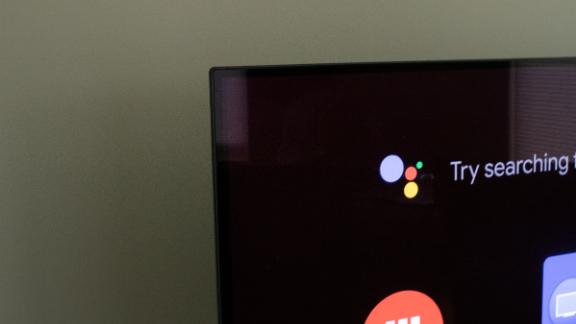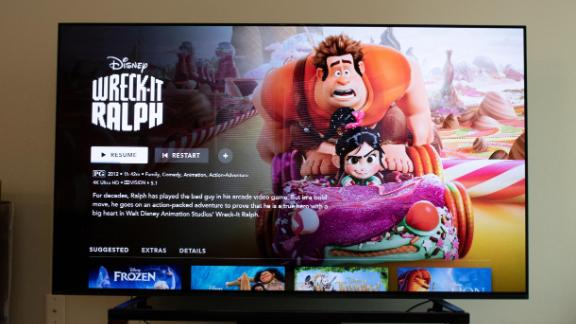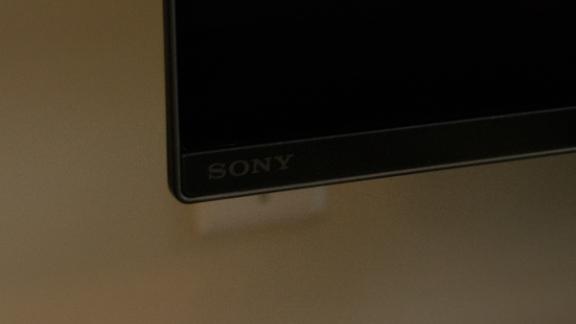The A8H is Sony’s new entry point for its expanding OLED TV family, but it comes with a cost. While OLEDs have started to come down in price, the 55-inch A8H is $1,898 and the 65-inch version is $2,798. Compare that to the OLED line Vizio will launch this fall, which has a starting price of $1,300.
Sony, along with LG, has been a mainstay for OLEDs for quite some time, and stays on the tried and trusted path of creative integrity. You won’t see flashy specs. Rather, the A8H aims to be flashy with a shockingly thin panel and an accurate image.
After several weeks with the 65-inch A8H, it’s safe to say the company succeeds on both accounts. Let’s dive into what’s good and bad about the A8H — and OLEDs in general.
What makes an OLED an OLED?

Let’s start with the basics. With an OLED TV, you have pixels emitting light and colors, which creates the image. It’s a fundamental difference from LED or LCD, and even QLED, as those are all transmissive (the backlighting goes through filters and panels to create the image).
OLEDs work by lighting each pixel; there are no backlit arrays. When electricity or a current is pushed through the panel, it creates an image. The individual pixels light up and emit, working in conjunction with one another to create the image. It’s just the panel, which allows for a super-thin design.
Since OLEDs can light each spot, individual contrasts and blacks are sharp. There can be a fire on one side immediately contrasted by a black night on the other. You’re left with a vibrant image that can also feature deep blacks. It’s impressive, but you might also find that OLEDs can’t get as bright.
You might think of burn-in, or at least the notion of it, when you think of OLEDs. Essentially, there’s a possibility that the OLED pixels will burn out, but it’s unlikely. Considering the popularity and multi-year lifespan of these devices, we don’t see it as a large problem. You can also get dead pixels on LCD-, LED- and QLED-based TVs.
Picture quality on the A8H

Sony’s A8H produces a remarkably sharp picture with accurate colors.
The OLED panel is half the equation with Sony’s A8H, which is powered by Sony’s X1 Ultimate Processor. This processor was previously saved for the flagship offerings, but this is proof that tech eventually trickles down. This is the same concept of how Apple’s Smart Connector started on the iPad Pro and is now on a $329 iPad. Pretty nuts.
Sony’s X1 Ultimate handles image processing, real-time upscaling of content, HDR upscaling and more. It’s a lot for one chip, but the A8H doesn’t lag.
With basic SDR content, like an original episode of “The Simpsons” streamed via Disney+, you’ll notice characters look sharper, but it also doesn’t introduce extra noise or artifacts onto the image. You also won’t get an overtly vibrant picture. In this case, the X1 Ultimate engages HDR Remastering, which takes the standard content, runs an analysis and handles optimizations. In comparison to TCL 6 or 8 Series TVs, that’s a large improvement.
Ultimately, Sony stands on top, as it doesn’t try to recreate the image or put a heavy twist on it. You’re left with an image that stays true to the original intentions — albeit one that we sometimes wish was brighter.
With any content, Sony works to present it in a clear and enjoyable fashion. You’ll notice no color banding and a lack of contouring, along with an accuracy of colors. With Disney’s “Tangled,” other TVs upped the colors a bit, likely through a combination of processing and a bright back panel. On the A8H, it didn’t look unnatural, but Rapunzel’s dress was noticeably darker.
Swapping to “Springsteen on Broadway” streamed in 4K with Dolby Vision, you get a very realistic view that is on par with the theater experience. With close up shots of Bruce Springsteen, his face is lit well — you can see the spotlights reflect off with shine on his forehead or even creating gray lighting on his black T-shirt.
There’s also an immediate drop off, which places you in the theater, as the background is just a deep black. It’s a great test for the contrast levels and deep blacks that the A8H can produce. The immersion is real and the picture quality is high.
With Dolby Vision-capable content, your picture mode will switch to “Dolby Vision Bright” or “Dolby Vision Dark.” We like the former the best, as it lets you see more and is more capable of filling a room.
As a whole, the A8H is bright, but not as bright as a QLED, LCD or LED panel. It can be frustrating with various content, but cycling through picture modes can increase the highlights or allow more light. You are, of course, limited to what the panel can produce, and Sony doesn’t give away any tech specs. You have the option of scrolling through 45 levels of brightness and can set it to the “max” mode, but you’ll notice this still doesn’t get as bright as a conventional LED or LCD panel.
Vivid mode gives you the most light and doesn’t introduce grain, which is important. It enhances the color as well, so whites have more warmth and colors look more vivid. Blacks stay deep as you would expect from an OLED.
The X1 Processor ensures that it doesn’t alter the content in a negative way. It does this by matching the shot with a database so that it can handle the objects found in the image to the best it can.
Sony’s all about the original intention and doesn’t want to make colors wildly pop unless that’s the way it was intended. It’s a cinematic experience that we enjoyed and videophiles will especially like.
Sound from the screen

Let’s face it: Any TV you buy in 2020, especially a high-end option, likely deserves a soundbar or full sound system. Manufacturers and panel makers alike have put the focus on picture quality and slimming designs, and an unfortunate outcome is a lower sound quality. With a 55-inch or 65-inch panel, down-firing speakers would do much to fill a room, but where do you put the speakers?
Well, Sony, like a few other makers, places the speakers behind the TV. And instead of speakers, these are actuators that physically vibrate to create sound. It’s equivalent to 32.5-inch drivers and can fill a room. Bass and lower tones will leave you wanting more, which is likely due to space constraints. The panel is thin, so you can actually feel it vibrate.
For the most part, though, it creates room-filling audio with a wide soundstage. We didn’t experience the introduction of muckiness with audio or extra noise. If you choose to pair the A8H, with a soundbar or sound system (which we recommend), the A8H’s left and right legs can be raised higher to accommodate a decent size soundbar under the TV. This saves space and is a nice touch.
A sleek design with smarts

We’ve already hinted at this, but Sony’s A8H feels like a flagship TV. It’s a stunning design — the screen goes right to the end, so the bezels are impressively thin.
Equally, the thickness of the TV is something to behold. There is a thicker portion on the back that houses the processor and other pieces of hardware, which also gives the A8H some weight.
Rather than a center stand, the A8H has a left and right side. Both of these are made out of metal and feel very sturdy. You also just pop them into the A8H, no screws needed. It’s a simple setup, to say the least. There are also spots for the wall mount on the back, and it supports VESA.
The only bezel runs along the bottom and contains a small white LED notification light at center, which engages when you click a button on the remote. On the extreme left, you’ll find a Sony logo that’s a stealthy gray. It’s a sleek design that feels incredibly high-end and looks good in almost any room —- either on a wall or a cabinet.
Sony’s remote, while sleeker than in the past, still feels like a classic remote with a lot of buttons. It’s not ergonomic, like Samsung’s QLED remotes or LG’s Magic Wand, but it’s a long rectangle with a slightly ergonomic design on the back.
You’ll get dedicated buttons for Netflix, Google Play and even the Google Assistant. You’ll also get classic numbers, a few customizable buttons, a big power button and core TV controls. There’s, of course, a circular directional pad to navigate the interface. It gets the job done, but it feels like an aging design.
And for smarts, Sony still opts for Android TV, essentially taking Google’s take on a TV entertainment system and opting for customizations.
You get full access to more than 5,000 apps on the Play Store, but some are missing. Core streaming services like Netflix, Hulu, YouTube, Disney+ and even HBO Max are all available. You can use the Google Assistant for pretty much anything, from searching for content to even adjust the volume.
The A8H can even be paired with a Google Assistant-enabled smart speaker that might be in your house. You can cast content like a movie or TV show from a phone, tablet or computer through the Google Cast standard. Amazon Alexa can be used for some controls, as well, but it’s not as integrated as Google. Apple’s AirPlay 2 and HomeKit are fully supported.
Sony supports the core three smart-home standards, which is a good thing. You’re not just tied to one system. It’s a holistic approach that leaves room for everyone. Better yet, you can use all of these at once.
Bottom line

Sony’s A8H is a fantastic OLED TV that delivers a sharp and accurate picture with astounding details. It’s all packed into a stunning design that aims to be the centerpiece of your room.
You can likely find a picture mode that works great for whatever you’re watching, and while you might ask for a brighter picture, we think you’ll still find the picture quality to pack a punch. Sound is also surprisingly good for actuators behind the display and support for the core three smart systems is impressive.
Yes, $1,898 for a 55-inch or $2,799 for a 65-inch is a lot. But you’re getting a cinematic experience that will last for many years.
How we tested
For our Sony A8H review, we tested the 65-inch model over several weeks with a range of content in a variety of lighting conditions. We watched several films, including “Thor: Ragnarok,” “Avengers: Endgame,” “Avengers: Infinity War,” “Springsteen on Broadway,” “Moana,” “Frozen II,” “Inside Out,” “Star Wars: The Force Awakens,” “Aquaman,” “Batman vs. Superman: Dawn of Justice” and “The Simpsons Movie,” among others. Additionally, we tested a range of TV shows, including “Below Deck Mediterranean,” “The Office,” “Parks and Recreation,” “The Bold Type,” “Friends,” “The Mandalorian,” “The Clone Wars” and “The Simpsons,” among others. All visuals tested on the display were streamed over Wi-Fi, direct ethernet, a direct file or through Blu-Ray. We also tested each piece of content in an array of picture modes.
Note: The prices above reflect the retailer’s listed price at the time of publication.
"TV" - Google News
July 02, 2020 at 05:01AM
https://ift.tt/3inn1ug
Sony's A8H OLED TV has a great picture, but comes with a high cost - CNN
"TV" - Google News
https://ift.tt/2T73uUP
Bagikan Berita Ini














0 Response to "Sony's A8H OLED TV has a great picture, but comes with a high cost - CNN"
Post a Comment